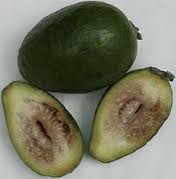Origin of Feijoa
Feijoa is native to
Uruguay, northern Argentina, western Paraguay, and southern Brazil’s highlands.
Today, it is grown in Australia, South Africa, Azerbaijan, parts of the US,
Russia, the Mediterranean regions of Europe, and India.
A German botanist
anointed feijoa after a Portuguese explorer, Joao de Silva Feijo. Much to the
disappointment of his sponsor, Feijo was initially appointed to exploit the
sulfur mines of Cape Verde but he preferred to spend his time chasing
butterflies, collecting seashells and plucking flowers. Feijo’s fame was
posthumous, as evident by the fact that his manuscripts were rescued out of a
Brazilian bakery that was using his documents as wrapping paper.
As explained by the World
Agro Forestry Centre, feijoas first appeared in Europe around 1887 in
Switzerland, and spread to France by 1890. According to Robert Paull’s book,
“Tropical Fruits,” guava species came to India by way of Portuguese explorers.
It was they who brought the fruit to its soils from the Philippines. Guavas,
with their prolific seeds, grew quickly and easily in India.
Today, the fruits grow in
Portugal, the Mediterranean, France, the UK, Portugal, New Zealand, South
Africa, North Africa, throughout South America, the Caribbean islands, and the
Caucasian region of Russia. New Zealand likely dedicates the greatest efforts
to the fruit’s cultivation and production. In fact, the country has its own New
Zealand Feijoa Growers Association.
Availability
Feijoa grows best in
regions with low humidity and a subtropical climate. In India, feijoas grow alongside
other guava cultivars, such as the chittidar variety in Uttar Pradesh and the
harijha in Bihar. Feijoas also grow in the Kodaikanal hills and the Nilgiri
station hills in south India.
 |
| Guava seller in Uttar Pradesh post-flood season |
Where to find Feijoas in India
Though guavas are
available year-round except for a few weeks in the summer, feijoas are highly
perishable and bruise easily. Thus, they are not always available outside of
the regions in which they grow. Feijoa’s turnover is both rapid and sporadic.
The best place to find
cheap, fresh feijoas in India is roadside stalls and small markets near guava
groves when in season. Uttar Pradesh in particular is renowned for its guavas.
Checking for Ripeness in Feijoa
Feijoas are green when
unripe, and turn yellowish green as they ripen. An unripe feijoa core’s flesh
is white and opaque, and turns gelatinous and creamy when ready for
consumption. As it nears spoiling, the flesh becomes brown but may still be
edible. Select guavas that gently yield to the touch.
Feijoas are beautifully
aromatic when ripe. Like other guava varieties, they too emit a musky, sweet,
strong and unique fragrance. This scent grows stronger as it nears peak
ripeness.
The surest indicator of
ripeness is when the feijoa fall from the tree. Because of its high
perishability, however, these fruits must be collected from the ground within a
day or two. Avoid the fruits with obvious marks, blemishes and cuts.
Note: an overripe feijoa
will rot internally before becoming apparent externally. Thus, consume feijoa
within a day or two if its ripeness is evident.
 |
| Ripe feijoa |
Storing Feijoas
Feijoas have a short
shelf life in humid, hot temperatures, but will keep for a month in cool
storage.
Frozen feijoa pulp lasts up
to a year. To freeze, halve the fruits and scoop out the flesh. Transfer to a
vacuum-sealed baggie. Or, place the flesh in ice cube trays and use in frozen
alcoholic beverages, smoothies, or juices.
Feijoas are best enjoyed
at room temperature, as the subtle notes of the fruit disappear when chilled.
 |
| Perfectly ripe feijoas |
Taste of Feijoa
The taste of ripe feijoa
is a mélange of pineapple, papaya, lemon, strawberry and guava. Its other
moniker, pineapple guava, comes from its similarity in taste. Feijoas also
possesses minty, wintergreen overtones.
The flesh’s taste and
texture varies: near the skin, it is granular like a pear. Near the center of
the fruit, the flesh is sweeter, custardy, watery and jelly-like. Some cite
that the fruit bears an unpalatable medicinal taste. Such is usually the case if it was a wild fruit
or came from a poorly maintained shrub.
Though the thin green
skin may be bitter and unpleasant, it is nonetheless edible. Unlike other guava
varieties with rock hard seeds, feijoa has 20 to 40 small yet edible seeds.
Some spit these out, but they are seldom removed when the flesh is called for
in recipes.
Nutritional Value of Feijoa
According to the USDA
nutrient database, 100g of feijoa contains the following values:
119kcal
2g Fat (3% RDI)
26g Carb (9% RDI)
3g Protein (6% RDI)
49.3mg Vitamin C (82%
RDI)
.1mg Riboflavin (5% RDI)
.7mg Niacin (4% RDI)
.1mg Vitamin B6 (6% RDI)
92.3mcg Folate (23% RDI)
.6mg Pantothenic Acid (6%
RDI)
41.3 Calcium (4% RDI)
.2mg Iron (1% RDI)
21.9mg Magnesium (5% RDI)
48.6mg Phosphorous (5%
RDI)
377mg Potassium (11% RDI)
.1mg Zinc (1% RDI)
.1mg Copper (7% RDI)
.2mg Manganese (10% RDI)
Health Benefits of Feijoa
Feijoas have several
traditional medicinal applications, including combatting dysentery and cholera,
and acting as a bactericide. Being high in vitamin C, feijoas aid in remedying
coughs and colds while boosting the immune system and assisting with oral and
bone health.
The medical community has
affirmed many of feijoa’s traditional uses:
--A 2012 study published
in Pharmaceutical Biology indicates
that feijoas have remarkable antioxidant
activity.
--Italian researchers
published a study in the Journal of
Medicinal Food revealing that feijoa extracts have strong antibacterial and
antifungal activities, outperforming
metronidazole in some cases.
--Die Pharmazie published findings by Egyptian scientists
illustrating that the leaf extracts improved
bone mineralization
--European scientists
published a study in The International
Journal of Biochemistry and Cell Biology indicating that the fruit
possesses anti-cancer properties.
--According to a study
published in the Journal of Agricultural
and Food Chemistry, feijoas have anti-inflammatory
compounds.
How to Open and Prepare Feijoas
Open feijoas by cutting
the fruits in half and scooping out the flesh with a spoon. If eating out of
hand, it’s possible to scrape or bite a small hole in the skin and slurp the
gelatinous pulp.
Feijoa’s pulp browns
quickly once exposed to oxygen. To maintain its whitish color, sprinkle lemon
and limejuice atop the fruit: This will prevent browning.
Feijoa Recipe Ideas and Uses
Feijoas have several
culinary applications ranging from succulent desserts to bright, zesty salads.
The fruit may also be cooked without losing its sweetness.
--Stir the creamy pulp
into yogurts, ice cream, and custards.
--Cut
into chunks and add to tropical fruit
salads. The fruit pairs well with cut pineapple, papaya, mango, lime, and
kiwi.
--Make a guava glaze and add to tofu and baked
vegetables: Mix ____
--Substitute guava for
mangos in any chutney recipe
--Stew the fruit for a syrupy dessert akin to poached peaches and
pears
--Blend
feijoa pulp with bananas and nut milk to make tropical milkshake. Also consider freezing the guava pulp before
blending it, as this will add a frozen, slushy consistency to the drink.
--Feijoa
goes well in a variety of alcohols; some countries infuse it in vodkas; New
Zealanders make ciders from feijoa,
and South Asians make wine.
--Make feijoa wine by adding yeast and acids,
then fermenting the fruit over the course of three months. It’s recommended to
freeze the fruit and de-thaw before brewing as a way to bring out the robust
flavors.
--Make feijoa jam using of 4 cups of sugar
for every 1kg of fruit. Add water and lemon for additional consistency and
flavor.
--Include feijoa chunks
in salsa recipes. With the addition
of chopped cilantro, onion, black pepper, salt, cinnamon and nutmeg, sliced
feijoa makes a robust addition to glazed tofu dishes and serves beautifully as
a garnish.
--Use
feijoa pulp in dessert whip recipes:
because the flavor is so pungent, only a small amount of flesh is necessary to
create a nice guava flavor
--Freeze and blend fruit
in daiquiri recipes
--Dip feijoa slices into chocolate.
Garnish with freshly chopped mint to bring out the fruit’s spearmint overtones.
--Make fruit leather by simmering the blended
pulp on the stovetop and reducing until the texture is smooth and sweet,
stirring every half an hour. Though the process may take half a day of
simmering, the chewy, sweet treats will keep for months in an airtight
container.
--The flower petals of the feijoa tree are
also edible: their crunchiness adds a nice texture to salads and the flavor is
sweet with hints of cinnamon. The reddish
purple hue of the flower adds gorgeous color to any dish.
Flavor Complements
Fruit: Cattley
guava, banana, mango, passion fruit, coconut, pineapple, mango, custard apple, apple
(especially green), lime, lemon, orange, pear, kiwi, papaya, asian pear,
occidental pear
Vegetables: Cucumber, water chestnut
Herbs, spices, and oil: mint, basil, limejuice, lemon juice, lemongrass,
eucalyptus, peppermint tea, coconut milk, coconut shreds, macadamia nut,
cashew, pistachio, rose, vanilla, vodka, rum, honey, maple syrup, salt, pepper,
cilantro, bay leaf, vinegar, nut cheese, barbeque, smoky essence, tamarind
paste, mustard, ginger, garlic, onion, balsamic vinegar, sherry, apple cider
vinegar, cinnamon, clove, cardamom, mace, raisin, chili, chocolate, black tea
Random Fact:
The compound responsible
for guava’s strong, musky aroma is ester methyl benzoate.
Other specimens in the Myrtaceae family include guavas, clove,
and eucalyptus
Scientific Name:
Feijoa sellowiana
Acca sellowiana
Other Names:
Pineapple
guava
Brazilian guava
Fig guava
Guavasteen
New Zealand banana
 |
| Feijoa pear jam from gourmetrecepies.com |











No comments:
Post a Comment